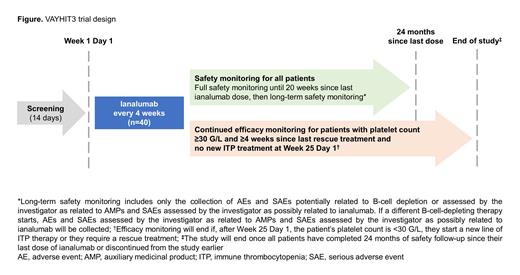Background: In patients with ITP, autoreactive B cells mediate the production of autoantibodies that target platelets and megakaryocytes, resulting in an increased rate of platelet destruction and decreased platelet production. B-cell activating factor (BAFF) regulates the differentiation, proliferation and survival of B cells via interactions with the BAFF receptor (BAFF-R). Patients with ITP have elevated serum BAFF levels, which positively correlate with increased disease activity. Ianalumab is a novel, fully human immunoglobulin G1 monoclonal antibody that targets BAFF-R and has a unique dual mechanism of action: direct B-cell depletion mediated by antibody-dependent cellular cytotoxicity and inhibition of B-cell differentiation, proliferation and survival via blockade of BAFF-R-mediated signaling.
Following first-line corticosteroids, TPO-RAs are a standard second-line treatment for ITP; however, patients often require chronic TPO-RA treatment and endure potential side effects with increased costs. For patients who previously received corticosteroids and a TPO-RA, the choice of subsequent therapy (eg a different TPO-RA, rituximab, fostamatinib, mycophenolate mofetil, splenectomy) is not well defined. Thus, in patients with ITP requiring additional lines of therapy, there is an unmet need for new, well-tolerated therapies with disease-modifying potential that can safely induce high response rates after a short therapeutic course and maintain durable responses after treatment discontinuation.
Trial design: VAYHIT3 (NCT05885555) is a multicenter, open-label, single-arm, Phase II trial enrolling approximately 40 adult patients with primary ITP who have previously received at least 1 corticosteroid and 1 TPO-RA. Additional prior therapies are allowed. Eligible patients must have lost response, had an insufficient response, had no response or been intolerant to their last ITP therapy. Along with a platelet count of <30 G/L, patients must be assessed by the investigator as needing treatment. Exclusion criteria include a neutrophil count of <1000/mm 3 and prior splenectomy. All patients will receive intravenous ianalumab every 4 weeks (Figure). Patients may receive concomitant therapy with a corticosteroid or TPO-RA if clinically indicated, which may be tapered. The primary efficacy analysis will occur after all patients have been followed up until Week 25 Day 1 or discontinued the study earlier. All patients with a platelet count of ≥30 G/L in the absence of a rescue therapy in the last 4 weeks or new ITP therapy at Week 25 Day 1 visit will continue efficacy monitoring until they have a platelet count of <30 G/L, start a new ITP therapy or require a rescue therapy. Safety will be monitored in all patients for up to 2 years after the last dose of ianalumab.
Endpoints: The primary endpoint is confirmed response, defined as a platelet count of ≥50 G/L for 2 or more consecutive assessments at least 7 days apart between Week 1 Day 1 and Week 25 Day 1 visits and in the absence of both a rescue therapy for ≥4 weeks prior to the assessment of platelet count and the receipt of a new ITP therapy. Secondary endpoints include time to confirmed response, time to loss of response, quality and stability of response, proportions of patients experiencing bleeding events and requiring rescue therapies, changes in B cell and immunoglobulin levels, and pharmacokinetics, immunogenicity and safety of ianalumab. Exploratory biomarker assessments are also included to expand upon the understanding of ianalumab pharmacodynamics and exposure-response in patients with ITP.
Conclusions: VAYHIT3 will evaluate the ability of a short therapeutic course of ianalumab to induce durable responses in patients who have received 2 or more prior lines of therapy, including at least 1 corticosteroid and 1 TPO-RA, for whom significant unmet needs exist.
Current status: VAYHIT3 is recruiting. Ianalumab is also being investigated in 2 ongoing, randomized, double-blind, Phase III ITP trials: VAYHIT1 (NCT05653349) is assessing ianalumab versus placebo in addition to first-line corticosteroids, and VAYHIT2 (NCT05653219) is assessing ianalumab versus placebo in addition to eltrombopag in patients who failed first-line corticosteroid treatment.
OffLabel Disclosure:
Kuter:AIRx, Alexion (Syntimmune), Alnylam, Alpine, Amgen, argenx, BioCryst, Bristol Myers Squibb (BMS), Caremark, Cellularity, Cellphire, Chugai, CRICO, Daiichi Sankyo, Dianthus, Electra Therapeutics, Fuji, Hemopure, Hengrui. Immunovant, Incyte, Inmagenebio: Consultancy; AIRx, Alexion (Syntimmune), Alnylam, Alpine, Amgen, Argenx, BioCryst, Bristol Myers Squibb (BMS), Caremark, Cellularity, Cellphire, Chugai, CRICO, Daiichi Sankyo, Dianthus, Electra Therapeutics, Fuji, Hemopure, Hengrui, Immunovant, Incyte, Inmagenebio, Ke: Honoraria; Rubius: Current equity holder in publicly-traded company; UpToDate: Patents & Royalties: UpToDate Chapters; Platelet Disorder Support Association: Membership on an entity's Board of Directors or advisory committees; Kezar, Kyowa-Kirin, Merck Sharp & Dohme: Honoraria; Kezar, Kyowa-Kirin, Merck Sharp Dohme, Momenta, Novartis, Nuvig, Pfizer, Platelet Biogenesis, Platelet Disorder Support Association, Protagonist, Rigel, Sanofi (Bioveratif), Sanofi (Principia), Sanofi (Genzyme), Sobi (Dova), Takeda, UCB, Up-To-Date, Zafge: Consultancy; Alnylam, BioCryst, Novartis, Rigel, Sanofi (Principia), Takeda (Bioverativ), and UCB: Research Funding. Bradbury:Novartis: Consultancy, Speakers Bureau; Amgen: Research Funding, Speakers Bureau; BMS-Pfizer: Speakers Bureau; Bayer: Speakers Bureau; Sobi: Speakers Bureau; Sanofi: Speakers Bureau; Janssen: Speakers Bureau; Lilly: Consultancy, Speakers Bureau. Allepuz:Novartis: Current Employment. Pfender:Novartis: Current Employment, Current equity holder in publicly-traded company. Haenig:Novartis Pharma AG: Current Employment, Current equity holder in publicly-traded company. Nowak:Novartis: Current Employment. Gonzalez-Lopez:Momenta: Honoraria; Grifols: Honoraria, Research Funding; Sobi: Honoraria, Research Funding; Novartis: Honoraria, Research Funding; Amgen: Honoraria, Research Funding; Alpine: Honoraria; Argenx: Honoraria.
Off-label uses of rituximab and mycophenolate mofetil are mentioned in the Background section to explain that they are sometimes used to treat patients with ITP.


This feature is available to Subscribers Only
Sign In or Create an Account Close Modal